When it comes to single-action revolvers, commonly referred to as cowboy guns, America’s appetite seems alive and healthy. Nostalgia plays a part in this interest, and so does Cowboy Action Shooting. We tested three revolvers whose forebears may have vied for sales in the Old West beginning in 1873. The Taylor’s & Company Devil Anse is named after a famous American gunner and is a Colt Single Action Army clone. The Taylor’s & Company Remington 1858 conversion is a reproduction of the typical conversions performed on original cap-and-ball revolvers. This revolver retains the ability to fire black powder in the cap-and-ball fashion if the shooter purchases a black-powder cylinder. We also tested a reproduction of the Smith & Wesson Schofield revolver. This is a clone of Smith & Wesson’s break-top revolver that was intended to compete with Colt’s original SAA revolver. The Smith & Wesson was successful in overseas sales and had some success in the states as well. It should be stressed that there is no clear purpose for these handguns, other than pride of ownership and recreational shooting. Our research indicates the SAA type is preferred above all others in Cowboy Action Shooting, although a few use competing types.
How We Tested
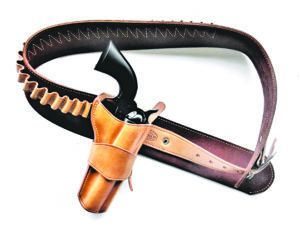
We were able to get together six types of ammunition for the test. We used the Winchester 255-grain round-nose load, Black Hills Ammunition’s 250-grain cowboy load, Remington’s 230-grain jacketed hollow points, a few Blazer 200-grain jacketed hollow-point loads, and a handload using the MattsBullets.com 255-grain bullet and Titegroup powder for 783 fps. Interestingly, the Remington, with its 8-inch barrel, developed the lowest velocity of the three revolvers. Also, we attempted to use 45 Colt Aguila loads, but we found the ammo’s low report and light recoil concerning. When we clocked three rounds of this on the chronograph, we found velocities of 415 fps, 360 fps, and 390 fps. Cowboy loads usually clock about 650 fps, so we felt there was some danger of a bullet sticking in the barrel. The Aguila loads were much too light. We used the handloads primarily during offhand firing, setting off 36 rounds in each revolver. We fired quickly, firing with one hand at 5 and 7 yards and two handed at 15 yards.
Read on to discover which revolver you may enjoy the most and to see which one fits your style.
Gun Tests Grade: A (BEST BUY)
$638
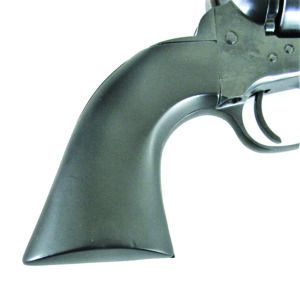
Taylor’s lists the revolver at $587 for the standard version and $784 for the tuned version. Current retail is a bit higher in most shops, and we had to pay $625 for our example. We have not tested the tuned version, but based on our revolver for general shooting, it is fine as it is. The Devil Anse is named for Devil Anse Hatfield of the famous Hatfield and McCoy feud. This 4¾-inch-barrel revolver is all blued steel. This is a very attractive finish. The hammer is case hardened in finish. The grips are simple oiled walnut, and Taylor’s calls them “Navy”-size grips to approximate the grip size of the Colt Navy. The front sight is a simple post, and the rear sight is usual groove in the top strap. A bonus compared to some revolvers we have tested is that the sights are well regulated for 255-grain loads. The revolver is loaded by placing the hammer on half cock and indexing the cylinder to load one chamber at a time. To eject spent cartridges the chambers are lined up with the ejector rod and ejected one at a time. The ejector rod is spring loaded. The process is no faster than the Remington to load, but it is much faster to unload spent cartridges. The hammer is smooth in operation, and the trigger action is best of the test at 4½ pounds.
| Action Type | Single-action revolver |
| Overall length | 10.25 in. |
| Overall Height | 5.5 in. |
| Capacity | 6 |
| Weight Unloaded | 36.0 oz. |
| Weight Loaded | 39.0 oz. |
| Barrel Length | 4.75 in. |
| Maximum Width | 1.6 in. |
| Frame | Steel |
| Front Strap Height | 2.1 in. |
| Back Strap Height | 3.4 in. |
| Grips | Wood |
| Grip Thickness Max | 1.5 in. |
| Grip circumference Max | 5.9 in. |
| Sights | Fixed |
| Sight Radius | 5.75 in. |
| Trigger Pull Weight | 4.6 lbs. |
| Safety | No Manual Safety |
| Warranty | 1 year |
| Telephone | (540) 722-2017 |
| Website | TaylorsFirearms.com |
| Made In | Italy |
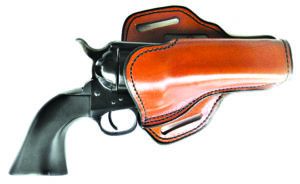
The revolver is very well balanced. These barrel length SAA revolvers were often called the Gunfighters Gun, and they are faster from leather and faster on target than the longer-barrel revolvers. This revolver does not use a transfer bar system and must never be carried fully loaded. Load one, skip a chamber, load four, cock the hammer and lower on an empty chamber is the rule if you carry the revolver hiking or hunting.
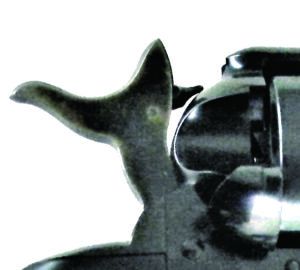
On the firing range, the Devil Anse proved fast from leather, drawing from a Galco 1880 holster. The revolver is fast and provided excellent speed to a center hit. Notably, if you sped up much, the Remington came close in performance, but with practice the Single Action Army type revolver is fast and accurate in close-range firing. One of our raters carries his single-action 45 when hiking and traveling in Appalachia. The combination of reliability, speed, and power even against dangerous animals has earned his trust over the past 40 years. After firing only a few cartridges, he remarked that the Devil Anse is among his favorites. The Devil Anse was the clear winner in combat shooting despite a loading speed advantage given the Smith & Wesson.
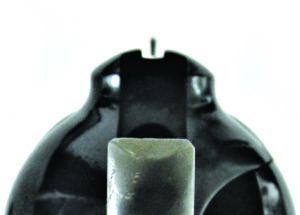
In accuracy firing from a bench rest, the Devil Anse was not as accurate as the Remington copy, but it was more accurate than the Schofield. We also noted that recoil was the greatest of the test with this 36-ounce revolver. That was to be expected. The Remington was more comfortable to fire, and the Schofield seemed the most comfortable of the three. The Devil Anse is easily accurate enough for Cowboy Action or outdoors use. As one rater pointed out, a lot of folks still use the SAA as a house gun or camp gun, and the Devil Anse is the only revolver tested suitable for that role, in his opinion.
Our Team Said: The Devil Anse happens to be the least expensive revolver tested. It is among a very few imports we have tested that seemed the equal of Colt SAA revolvers tested in the past, in fact superior to a couple of Colt revolvers we have fired recently. The Devil Anse SAA Clone is the only piece with utility for field use, we feel.
45 Colt Range Data
All groups were fired at 25 yards from a benchrest position using an MTM Universal Shooting rest. We used a Competition Electronics Pro Chrony to measure velocities. The first screen of the chronograph was 10 feet from the muzzle of the firearm.| Black Hills 250-grain Cowboy | Taylor’s Devil Anse | Taylor’s Remington 1858 | Cimarron Schofield |
| Average Velocity | 699 fps | 675 fps | 714 fps |
| Muzzle Energy | 271 ft.-lbs. | 253 ft.-lbs. | 283 ft.-lbs. |
| Smallest group | 1.8 in. | 1.6 in. | 2.9 in. |
| Average Group | 2.4 in | 2.1 in. | 4.0 in. |
| Winchester 255-grain RNL | Taylor’s Devil Anse | Taylor’s Remington 1858 | Cimarron Schofield |
| Average Velocity | 694 fps | 671 fps | 688 fps |
| Muzzle Energy | 273 ft.-lbs. | 255 ft.-lbs. | 268 ft.-lbs. |
| Smallest Group | 2.5 in. | 2.0 in. | 3.8 in. |
| Average Group | 2.9 in. | 3.3 in. | 4.4 in. |
| Remington 230-grain JHP | Taylor’s Devil Anse | Taylor’s Remington 1858 | Cimarron Schofield |
| Average Velocity | 865 fps | 857 fps | 880 fps |
| Muzzle Energy | 382 ft.-lbs. | 375 ft.-lbs. | 395 ft.-lbs. |
| Smallest Group | 2.7 in. | 2.5 in. | 3.6 in. |
| Average Group | 2.9 in. | 2.9 in. | 4.2 in. |




























Thanks for the review, their is not many reviews out there on this revolver…
Yes, the Taylors & Company Devil Anse 45LC “does have a transfer bar”, its built inside of the hammer and retracts the firing pin back from connecting to the round unless the hammer is fully cocked. Its not a fixed firing pin.
Jim
Hi Jim…yes I was waiting for someone to say this. My Devil Anse does appear to have the retracting firing pin, in spite of tests that say it doesn’t. It’s still a cool piece for my collection but I wish it had the old style hammer/pin.
Yes, They are no longer making any of them without the Retractable Firing Pin.
Such a shame though…